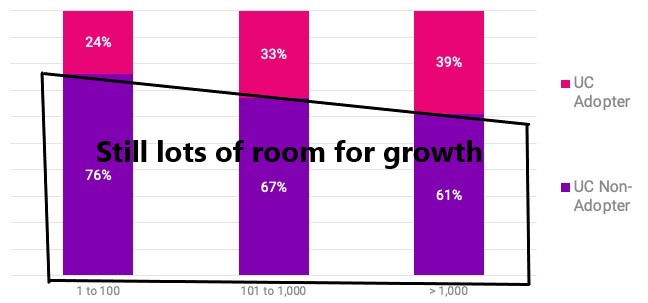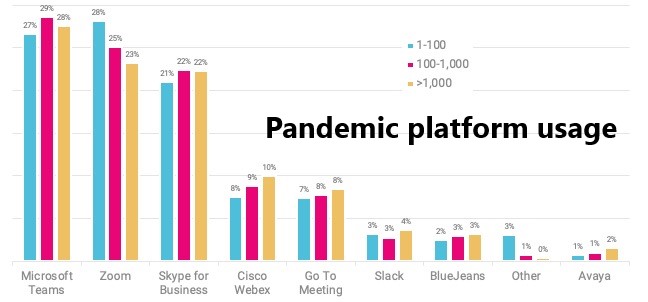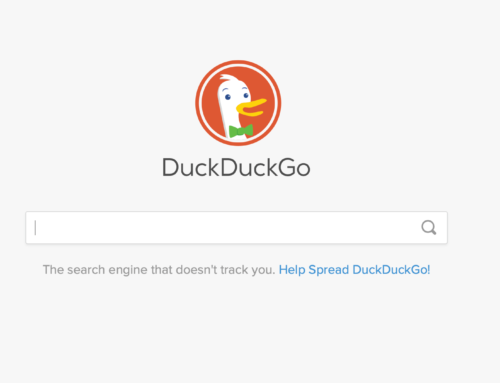The results from Ribbon’s annual survey on UC adoption are in.
Conducted in November 2020, the study tallied responses from 4,500 technology decision makers in 18 countries in the Americas and Europe.
UC adoption was strong last year. It especially gained strength in the small and mid-markets, up 24% and 33% respectively.
For larger market segments, a lot of the increase was no doubt the result of projects already in the planning stages prior to the pandemic.
However, for SMBs it was a different story. According to Ribbon’s John Macario, Sr. VP of Enterprise and Channel Marketing, having someone managing IT in house could be the difference.
“In the past, the UC provider probably wasn’t talking to a tech-savvy buyer,” said Macario. “If you said SIP, they might have thought you were talking about a cappuccino.” Now more than half of SMBs have an IT person who knows what this means, making it easier for a UC provider to sell their technology.
The takeaway: not only did the pandemic bring awareness of UC to more small businesses, it may have also brought them someone who understands it.

There was a notable shift in how small businesses (<100 employees) managed IT during 2020. The 2019 survey found that 33% of them managed IT in house; in 2020 that number jumped to 54%.
The biggest shift in these numbers came from the 18% who reported in 2019 that they did not manage IT in any meaningful way. Focusing on running the business and letting technology take care of itself had been working for them. The pandemic proved otherwise. In 2020, only 4% got by without someone dedicated to IT.
Using outside companies to manage IT declined some but is still a viable solution for 28% of small businesses.
The takeaway: small businesses recognize that having a solid solution for managing IT is, and will continue to be, a critical issue.

Ribbon also looked at current platform usage for collaboration, as well as future plans.
Collaboration is of particular interest to Ribbon as they provide several solutions for connecting users between Teams, SIP and PSTN trunks, and legacy PBXs.Their Microsoft-certified SBCs come in a variety of sizes and deployment options, including cloud-hosted models. For organizations using Zoom, Ribbon offers Zoom-certified SBCs so organizations can easily and securely connect to the platform. And they provide secure, resilient voice communications to and from Skype for Business on-premises and online.
The top three platforms used in 2020 were Teams, Zoom, and Skype for business. These made up the lion’s share.
For medium and large organizations, all solutions outside of these three garnered a combined total of less than 20% of the market. Even for small businesses, all platforms used that were not Microsoft and not Zoom only reached a combined total of 35% of usage.
Market share for Skype for Business, with end-of-life slated for later this year, is up for grabs. Is it a given that those users will migrate to Teams?
Not necessarily, says Macario.
Although many will stick to a full Microsoft solution, some won’t. And although smaller companies had the larger share of “not Microsoft and not Zoom” usage in 2020, larger organizations may be the ones more willing to evaluate all options.
Having a completely integrated IT stack may be easiest, but larger businesses will look at all factors. This includes economic benefits as well as user satisfaction.
The takeaway: Microsoft and Zoom are here to stay, but alternate platforms can still make their mark by providing decisive differentiators.

Planning for disaster recovery and business continuity is something many large organizations pride themselves on.
They have studied the Gartner reports, dispersed deployments geographically, and sourced multiple network providers. They have long been supporting road warriors and the occasional home worker.
Around half of large businesses felt “well prepared” to support remote workers going into 2020. Almost as many mid-sized businesses were pretty confident, too.
So how did that work out? Not so well.
Across the board, regardless of planning, everyone was hit hard.
At least a third of businesses of all sizes and levels of preparation were “greatly impacted, and another third was “moderately impacted.”
I asked Mr. Macario for his thoughts on this. He had an interesting observation.
The survey asked, “how well prepared was your company to support remote workers,” not “did you have the right tools and infrastructure in place.” A subtle yet important difference.
“Ultimately nobody was prepared for this,” said Macario.
The takeaway: add another dimension to your disaster plans. Planning for a sudden fire or flood often focuses on a fast, but a short-term solution. Pandemics change business structures for the long haul.
Overall, Ribbon’s survey shows that while adoption of UC was up last year, there is still significant opportunity among those not yet committed.
The advantage will go to UC providers and support organizations that address all aspects of what the future may hold.
This includes a greater percentage of employees working from home permanently and prolonged travel restrictions. It may also include supporting “work from RV” or “you get to come into work day” for employees weary of the lockdown.
In all cases plan to be safe, be prepared, and be relevant.
Need help marketing your UC application or service? Town Crier can help. Give us a call at 214-732-7770, email tracy@towncriergroup.com or visit www.towncriergroup.com





![B2B Leads: How Many Do You Need? [Here’s How to Find Out]](https://towncriergroup.com/wp-content/uploads/2021/03/entry-conversion-exit-shutterstock_539917381-scaled-500x383.jpg)